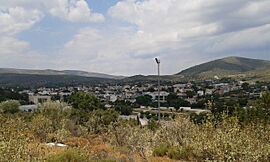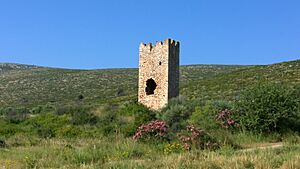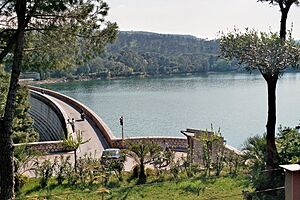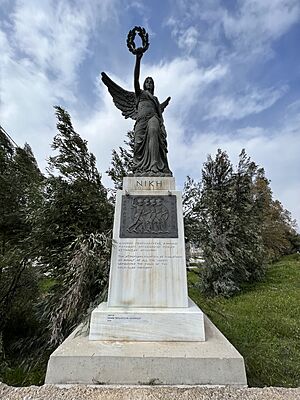Marathon, Greece facts for kids
Quick facts for kids
Marathon
Μαραθώνας
|
|
|---|---|

The town of Marathon
|
|
| Country | Greece |
| Administrative region | Attica |
| Regional unit | East Attica |
| Area | |
| • Municipality | 222.75 km2 (86.00 sq mi) |
| • Municipal unit | 97.06 km2 (37.48 sq mi) |
| Elevation | 33 m (108 ft) |
| Population
(2021)
|
|
| • Municipality | 31,331 |
| • Municipality density | 140.655/km2 (364.296/sq mi) |
| • Municipal unit | 10,063 |
| • Municipal unit density | 103.678/km2 (268.525/sq mi) |
| Time zone | UTC+2 (EET) |
| • Summer (DST) | UTC+3 (EEST) |
| Postal code |
190 07
|
| Area code(s) | 22940 |
| Vehicle registration | Z |
| Website | www.marathon.gr |
| This article contains special characters. Without proper rendering support, you may see question marks, boxes, or other symbols. |
Marathon (in Greek: Μαραθώνας, Marathónas) is a famous town in Greece. It is known as the place where the historic Battle of Marathon happened in 490 BCE. In this battle, the Athenian army, even though they were greatly outnumbered, bravely defeated the Persians.
A famous story tells that after the battle, a Greek messenger named Pheidippides ran all the way from Marathon to Athens. He ran to announce the big victory. This legendary run is why we have the "marathon" running race today. Marathon is now part of the East Attica region, near Athens. It is a popular place for holidays and farming.
Contents
History of Marathon
The name "Marathon" (Μαραθών) comes from the Greek word for the plant fennel. In Ancient Greek, fennel was called márathon. So, Marathon literally means "a place full of fennel." People believe the town got its name because there was a lot of fennel growing there.
In ancient times, Marathon was a small plain in northeast ancient Attica. It included four areas: Marathon, Probalinthus, Tricorythus, and Oenoe. These areas together formed the Tetrapolis, which was one of the 12 districts of Attica.
Many Greek legends are connected to Marathon. It is said that the hero Theseus fought and defeated a fierce bull here. Also, the hero Heracles was honored in Marathon, and people believed he had a special place there. Marathon is even mentioned in Homer's famous story, the Odyssey.
The Battle of Marathon
Marathon became very famous because of the great battle fought there in 490 BCE. This was when the Athenians won a huge victory over the Persians. After the Greek general Miltiades defeated the Persian forces of Darius, the Persians planned to sail to Athens to attack the city.
But Miltiades quickly ordered his soldiers to march back to Athens very fast. By the time the Persian troops arrived, they saw the same Greek army waiting for them. This quick action saved Athens.
Modern Developments
In 1926, an American company started building the Marathon Dam in a valley above Marathon. This dam was built to provide water for Athens. It was finished in 1929. About 10 square kilometers of forest were flooded to create Lake Marathon.
The beach of Schinias is located southeast of Marathon. It is a popular spot for windsurfing. The Olympic Rowing Center, which was used for the 2004 Summer Olympics, is also there. Marathon was the starting point for the marathon races in both the 1896 and 2004 Summer Olympics.
Population Figures
Here's how the population of Marathon has changed over the years:
| Year | Town | Municipal unit | Municipality |
|---|---|---|---|
| 1981 | 4,841 | - | - |
| 1991 | 5,453 | 12,979 | - |
| 2001 | 4,399 | 8,882 | - |
| 2011 | 7,170 | 12,849 | 33,423 |
| 2021 | 5,260 | 10,063 | 31,331 |
Other smaller towns and villages in the area include Agios Panteleimonas, Kato Souli, Vranas, Avra, Vothon, Ano Souli, and Schinias.
Places to Visit

- The Soros is a special burial mound. It was built for the 192 Athenian soldiers who died in the Battle of Marathon. It is a key feature of the coastal plain and has a marble memorial stone.
- The Kato Souli Naval Transmission Facility has a very tall radio mast. At 250 meters, it is the tallest structure in Greece.
Sister Cities
Marathon has special connections with other cities around the world:
 Hopkinton, Massachusetts, United States
Hopkinton, Massachusetts, United States Xiamen, China
Xiamen, China
See also
 In Spanish: Maratón (Grecia) para niños
In Spanish: Maratón (Grecia) para niños






